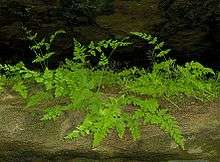Cystopteridaceae
Cystopteridaceae is a family of ferns in the order Polypodiales. In the Pteridophyte Phylogeny Group classification of 2016 (PPG I), the family is placed in the suborder Aspleniineae of the order Polypodiales, and includes three genera.[2] Alternatively, it may be treated as the subfamily Cystopteridoideae of a very broadly defined family Aspleniaceae.[3]
| Cystopteridaceae | |
|---|---|
 | |
| Scientific classification | |
| Kingdom: | Plantae |
| Clade: | Tracheophytes |
| Class: | Polypodiopsida |
| Order: | Polypodiales |
| Suborder: | Aspleniineae |
| Family: | Cystopteridaceae (Payer) Schmakov[1] |
| Genera[2][1] | |
| |
| Synonyms[3] | |
|
Cystopteridoideae Ching & Z.R.Wang | |
Cystopteridaceae are small or medium-sized ferns in forests and crevices.[4] They generally have thin laminae, and small, round, naked sori.
Genera
Three genera are accepted in the PPG I classification, and by the Checklist of Ferns and Lycophytes of the World as of November 2019:[2][1]
- Acystopteris Nakai
- Cystopteris Bernh.
- Gymnocarpium Newman
Cystopteris chinensis has been placed in a separate genus, Cystoathyrium, but the genus is not accepted by recent sources.[5][6]
Phylogenetic relationships
The following diagram for the Aspleniineae (eupolypods II), based on Lehtonen, 2011,[7] and Rothfels & al., 2012,[8] shows a likely phylogenic relationship between the Cystopteridaceae and the other families of the clade.
| Aspleniineae (eupolypods II) |
| ||||||||||||||||||||||||||||||||||||||||||||||||||||||
Gymnocarpium and Cystopteris have been found to be sister to the remaining Aspleniineae.[4]
References
- Hassler, Michael & Schmitt, Bernd (November 2019). "Cystopteridaceae". Checklist of Ferns and Lycophytes of the World. 8.11. Retrieved 2019-11-27.
- PPG I (2016). "A community-derived classification for extant lycophytes and ferns". Journal of Systematics and Evolution. 54 (6): 563–603. doi:10.1111/jse.12229.
- Christenhusz, Maarten J.M. & Chase, Mark W. (2014). "Trends and concepts in fern classification". Annals of Botany. 113 (9): 571–594. doi:10.1093/aob/mct299. PMC 3936591. PMID 24532607.
- Maarten J. M. Christenhusz; Xian-Chun Zhang; Harald Schneider (2011). "A linear sequence of extant families and genera of lycophytes and ferns" (PDF). Phytotaxa. 19: 7–54.
- Hassler, Michael & Schmitt, Bernd (November 2019). "Cystoathyrium chinense". Checklist of Ferns and Lycophytes of the World. 8.11. Retrieved 2019-11-27.
- "Cystopteris chinensis Ching". Plants of the World Online. Royal Botanic Gardens, Kew. Retrieved 2019-11-27.
- Samuli Lehtonen (2011). "Towards Resolving the Complete Fern Tree of Life" (PDF). PLoS ONE. 6 (10): e24851. doi:10.1371/journal.pone.0024851. PMC 3192703. PMID 22022365.
- Carl J. Rothfels; Anders Larsson; Li-Yaung Kuo; Petra Korall; Wen- Liang Chiou; Kathleen M. Pryer (2012). "Overcoming Deep Roots, Fast Rates, and Short Internodes to Resolve the Ancient Rapid Radiation of Eupolypod II Ferns". Systematic Biology. 61 (1): 70. doi:10.1093/sysbio/sys001. PMID 22223449.